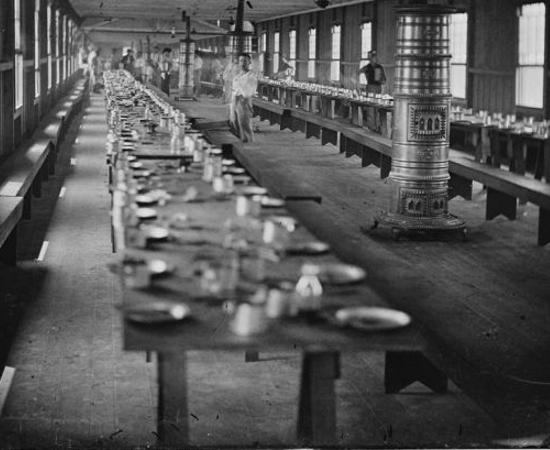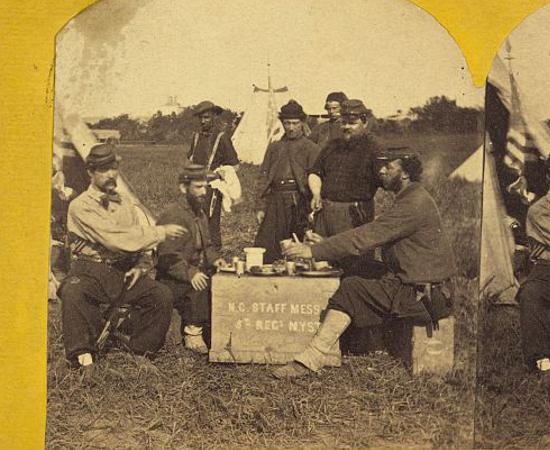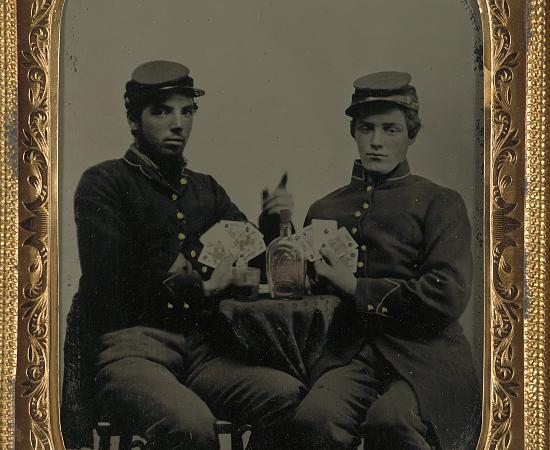
Members of the 93rd New York Infantry eat a meal – slightly nicer than typical fare – consisting of hardtack and salted pork.
I do not intend when I get home to live on wormy crackers and bacon, coffee and tea sweetened with molasses, mush or bread and molasses, sour corned beef, nor raw pork, as I have to when on a march.
Robert Cruikshank, New York State Volunteers, 1863 Library of Congress
One can read about the Civil War and become well versed on the battles, campaigns, and figures of the four year engagement. However, it is possible to deepen your understanding of the Civil War by experiencing the conditions of the soldiers. The Civil War Trust has compiled this list of seven things to taste in order to more fully experience this aspect of Civil War history.

Salt Pork
Salt pork was a staple of both the Union and Confederate armies throughout the war, and indeed a staple of warring armies from the 16th through 19th centuries. Salting pork allows the meat to last for a considerable time, without spoiling, at a low cost. It resembles uncut bacon, but, as the name suggests, is highly salted — often too highly during the war. Excess salt was usually scraped off and used to flavor other rations.
Taste it today: Salt pork has become a traditional part of different American cuisines and is available in grocery stores throughout the country. Salted pork is also incorporated in Pork and Beans, Boston Baked Beans, and many southern dishes.
Hard Tack
Much like modern military MREs, hard tack was cheap to make, easy to transport, and practically never spoiled — in fact, hard tack made during the Civil War still exists today. The tack was a rock-hard bland bread, baked in northern factories and shipped to Union soldiers on all fronts. It was so tough that many soldiers broke their teeth trying to eat it, and were forced to break it apart with rocks and rifle butts or soften it in coffee or grease.
Taste it today: Hard tack is still produced for a variety of demographics, including militaries and camping enthusiasts. In the United States, hard tack remains particularly popular among the native Alaskan population.
Cornmeal
Thanks to Northern embargos and naval blockades of Southern ports, the Confederate army never had the capacity to generate the quantity of hardtack produced by the Union. In response to the flour shortage, the South turned to a staple made from a more plentiful substitute - corn. Cornmeal is a kind of flour generated by crushing dried corn into a flour and was used to create Johnnie Cakes, a popular type of corn bread enjoyed by Confederate soldiers during the war.
Taste it today: Johnnie Cakes, also known as "hoecakes", remain a staple of American cuisine and are widely available in restaurants in both the North and the South. A quick Google search will produce a plethora of different traditional recipes for you to enjoy.
Molasses
Molasses is sugary, viscous syrup that was extremely popular in the 19th century. The syrup played a number of roles in the Civil War diet, mostly as a sweetener. It was often mixed into soups and daily dishes to add flavor, turned into candy and sweets, and was a key ingredient in the distillation of rum. Both Confederate and Union soldiers were issued molasses with their rations, though the supply was often disrupted, particularly for Confederate soldiers.
Taste it today: Molasses is widely available in modern grocery stores and is used as a topping for various dishes and in a number of cakes, cookies and deserts. Molasses cookies are particularly delicious.
Coffee
By the end of the 18th century, coffee had begun to supplant tea as Americans favorite caffeinated beverage of choice. Civilians and soldiers craved its rich bold flavor and revitalizing lift. When war broke out in 1861, coffee quickly became the most indispensable commodity a soldier consumed. Widely available to the Union Army, the boys in blue enjoyed scalding hot cups of the coveted brew nearly every day. In contrast, there was almost no coffee available in the South, as Union blockades prevented its importation. As a result, the desperate Confederate troops turned to creative alternatives. They often traded their ample tobacco rations with Union soldiers for coffee when the officers weren't looking, and boiled a number of other plants in an attempt to create coffee supplements.

Taste it today: Coffee remains a staple of the American diet and can be purchased at virtually any grocery store and coffee shop. Also try chicory flavored coffee, which a legacy of the Civil War. During the Union blockade, Southern people added chicory root to their coffee as flavor substitute.
Whiskey
The life of a soldier was often miserable, relentlessly stressful, and for long stretches, down right boring. As a result, soldiers of both sides inevitably turned to alcohol for entertainment and temporary escape from the stresses of war. Whiskey also played an important role as a widely administered source of medication in field hospitals — often used as an antiseptic and to dull pain.

Taste it today: Today's whiskeys bear very little resemblance to the potent whiskeys of the 19th century. The Civil War era rotgut was renowned for its strength and overpowering alcohol flavor. So, for those looking for a whiskey with a Civil War history, the modern Old Crow brand initially gained popularity during the Civil War, and was very popular in the late 19th century.
(Disclaimer: the Civil War Trust does not endorse the purchase or consumption of alcohol if you have health risks or if you are under 21. Follow all federal, state, and local regulations regarding the purchase and consumption of alcohol. You assume all liabilities and risks for the purchase and consumption of alcohol.)
Desiccated Vegetables
The Union also developed an innovative, yet far from delicious, method of delivering vegetables across huge swaths of land and over a long period of time: dehydrated vegetables. Carrots, onions, and celery were dehydrated and compressed into pucks that were then boiled and eaten in camp. Though they provided a valuable source of fiber and vitamins, soldiers hated the foul tasting concoction and more commonly referred to them as "desecrated vegetables".
Taste it today: Dried vegetables are still widely available and are enjoying growing popularity among healthy food enthusiasts — though the original, compressed pucks of fiber are no longer manufactured.
Condensed Milk
Land surveyor and entrepreneur Gail Borden was the first American to condense milk in 1853. His New York Condensed Milk Company supplied the Union Army with this popular food item during the war. Soldiers appreciated the milk's unique taste and longevity, since it could last for years if left unopened. Unfortunately this item was not a staple for Confederate soldiers, since Borden's factories were only located in the North.
Taste it today: Condensed milk is widely available at supermarkets and is used in many recipes.


